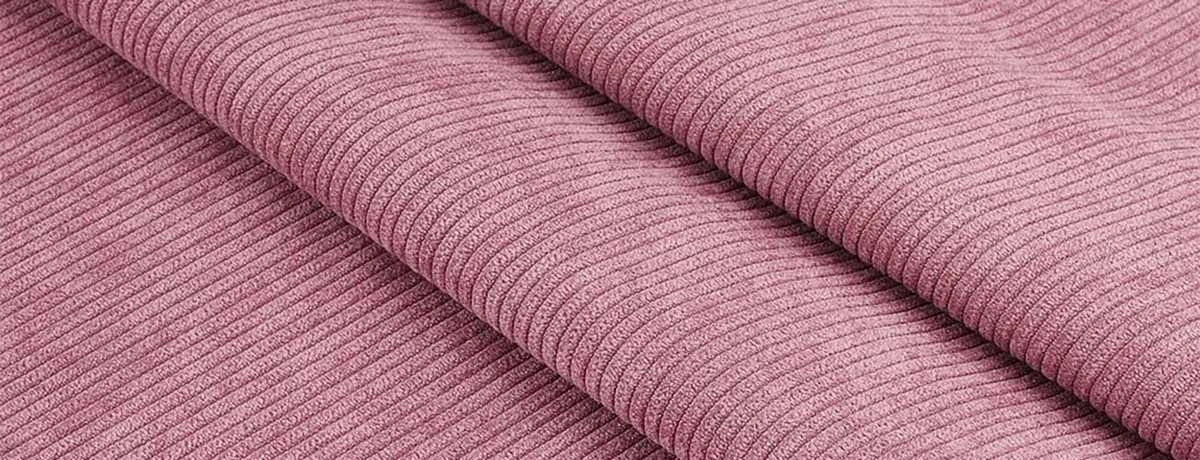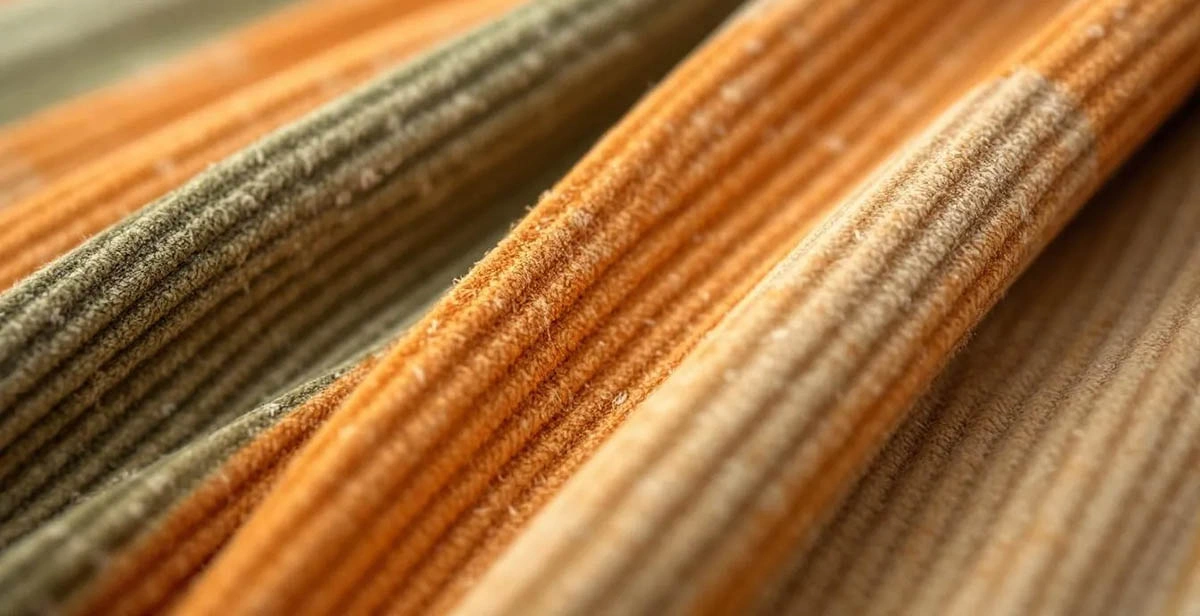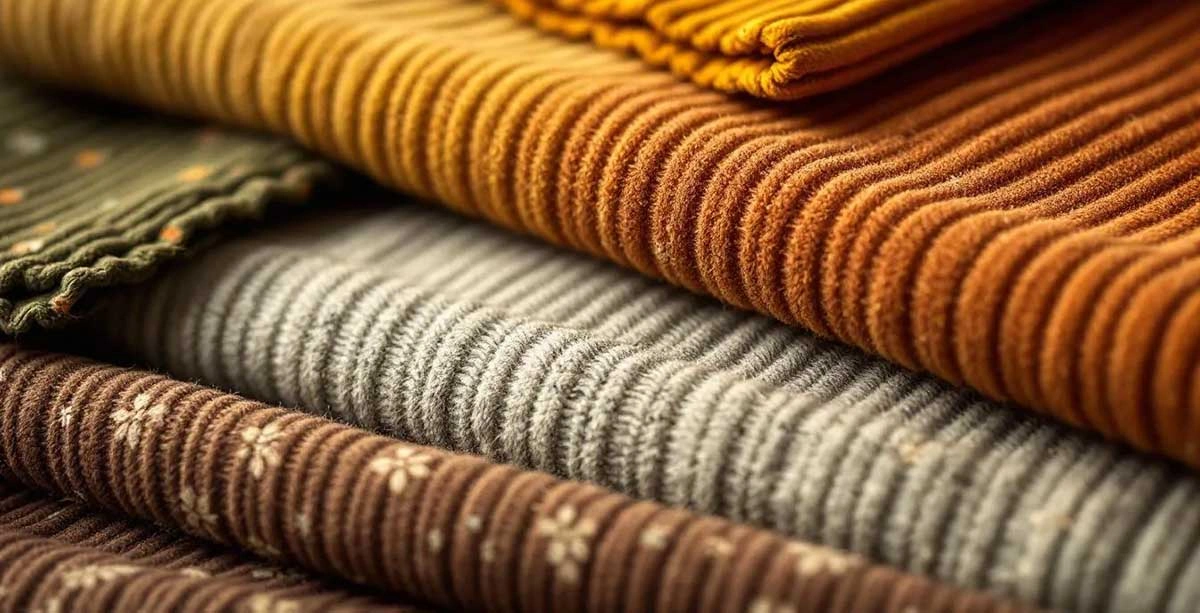Material Corduroy: Versatile Fabric for Fashion and Upholstery

Material corduroy is a durable fabric with unique vertical ridges. It’s popular in fashion and upholstery for its strength and texture. This article will cover its characteristics, history, making process, and uses.
Key Takeaways
-
Corduroy is a durable fabric with a unique texture created by vertical ridges, suitable for clothing and home decor.
-
The manufacturing process of corduroy has embraced technological advancements, enhancing quality and reducing costs.
-
Corduroy comes in various types, including standard, pinwale, and stretch, each tailored for different uses and styles.
Understanding Corduroy Fabric

Corduroy is a durable fabric known for its unique texture created by vertical ridges. The process of producing corduroy involves multiple distinct stages, including:
-
weaving
-
securing the pile
-
cutting
-
finishing
-
dyeing.
The intricate production process guarantees the fabric’s durability and unique look, making it popular for numerous applications.
Technical Aspects of Corduroy
Corduroy fabric is woven in a plain style with raised piles cut to form wales. The wale number and the number of wales per inch indicate the thickness and texture of the fabric—standard corduroy features 8-13 wales per square inch, while pinwale corduroy has finer ridges with up to 21 wales per square inch.
The wales provide wale corduroy with its distinctive appearance and texture, making it suitable for diverse garments and uses.
Historical Background
The roots of corduroy trace back to a fabric known as fustian, which originated in Egypt around 200 AD. Initially made from fustian, a fabric with a raised nap, corduroy evolved in Europe, particularly during the 18th century in England.
This transformation led to the contemporary corduroy, celebrated for its robustness and unique texture.
Modern Uses
Corduroy has diverse applications, ranging from clothing to upholstery. It is used in making:
-
Pants
-
Jackets
-
Skirts
-
Shirts Corduroy garments offer both style and durability. Its robust nature also makes it popular in home decor items like:
-
Pillows
-
Furniture covers
-
Curtains.
Beyond everyday wear, corduroy is utilized in workwear and uniforms for its resilience.
Manufacturing Process of Corduroy
Technological advancements in textile manufacturing have significantly impacted the production of corduroy. These advancements have enhanced the quality of corduroy fabrics by improving consistency and durability.
The enhancements in technology have also reduced energy requirements, which positively impacts production costs.
Weaving Techniques
Corduroy is primarily constructed using a plain weave pattern that alternates between warp and weft threads to form its characteristic design. This interlacing of yarn creates the raised ridges, giving corduroy its distinctive texture.
Sometimes, a twill weave can also be employed to achieve the desired effect.
Securing the Pile
Adhesive is applied to the back of the fabric to stabilize the pile yarn before cutting, preventing it from pulling through. This adhesive is later removed to preserve the fabric’s integrity.
This process ensures the uniformity and durability of the corduroy fabric.
Cutting and Finishing
Precision cutting tools are utilized to sever the pile yarn, ensuring the fabric has a uniform texture after brushing and singeing. These processes enhance the softness and uniformity of the fabric’s texture, making it easier to wash and sew.
The result is a smooth, even surface that is both aesthetically pleasing and functional.
Dyeing Methods
Pigment dye is a prevalent technique for achieving distinct designs in corduroy fabric. This method allows for unique patterns and different colors that enhance the fabric’s visual appeal. Subsequent washing further enhances the aesthetic qualities of the pigment dye fabric, making the mottled patterns stand out.
Applications of Corduroy Fabric
Corduroy is employed in a variety of clothing and upholstery, showcasing its versatility, including modern corduroy, corduroys, yard corduroy fabric, and garment options.
Its versatility in various uses highlights its status as a multifunctional textile.
Fashion Industry
Corduroy is widely used to create garments like pants, jackets, and overalls, and is also popular for furniture upholstery. Its durability and warmth make it perfect for winter clothing, and modern designers are now reimagining corduroy with fresh styles for spring and summer collections.
The rising popularity of retro and vintage fashion has greatly boosted the demand for corduroy fabric.
Home Decor
Corduroy is a favorite in home decor due to its durability, making it perfect for cushions and furniture upholstery. Its sturdy nature adds elegance and comfort to items like pillows and upholstery in any home.
Specialty Uses
Corduroy is frequently used in the production of durable workwear and casual clothing due to its strength and comfort. Its wear-resistant qualities make it a popular choice for uniforms and work attire, withstanding daily wear and tear.
This makes corduroy a preferred material in demanding applications.
Global Production of Corduroy
Corduroy is produced worldwide, with significant contributions from major textile-producing countries and other countries. Asia Pacific, particularly China and India, plays a crucial role in the corduroy market due to its growing textile industry and increasing consumer purchasing power.
The global corduroy market value was around $1.2 billion in 2023 and is expected to grow to approximately $2.1 billion by 2032.
Cost Factors of Corduroy Fabric
The corduroy fabric market is estimated to be valued at around USD 1.5 billion in 2023, with projections suggesting it could reach approximately USD 2.4 billion by 2032. This growth is driven by the high demand for innovative designs and diverse product offerings in the fashion industry.
Varieties of Corduroy Fabric

Corduroy can be made from cotton and blends with polyester or wool, or be fully synthetic. The fabric features distinct ridges, known as wales, which can vary in width and number, affecting texture and thickness.
This versatility allows corduroy to serve different types of needs and aesthetics, from standard corduroy to more specialized types like elephant cord and pinwale corduroy.
Standard Corduroy
Standard corduroy typically features 8-13 wales per inch, making it suitable for general use in clothing and accessories. This type of corduroy is widely used due to its balance of durability and softness, making it ideal for a range of applications from casual wear to fashion accessories.
Elephant Cord
Elephant cord is characterized by its large, thick wales that resemble the texture of elephant skin. Due to its robust texture, elephant cord is well-suited for heavy-duty garments and workwear. Its resilience makes it a preferred material in demanding applications, such as uniforms and outdoor clothing.
Pinwale Corduroy
Pinwale corduroy is known for having fine ridges that contribute to its unique texture. With up to 21 wales per inch, pinwale corduroy is lightweight and ideal for finely crafted garments.
Its delicate texture makes it suitable for soft, stylish and fashionable clothing items.
Pigment-Dyed Corduroy
Pigment-dyed corduroy is dyed in a way that creates a unique mottled look. This aesthetic appeal is enhanced through washing, making the mottled patterns more pronounced. The result is a washed fabric that stands out for its visual appeal and unique texture, suitable for a variety of garments and accessories.
Stretch Corduroy
Stretch corduroy is created by blending traditional corduroy fibers with spandex, allowing for greater flexibility and comfort. This makes it a popular choice for children’s apparel and active clothing due to the added comfort and flexibility.
The incorporation of elastic fibers enhances the fabric’s versatility, making it suitable for a wide range of applications.
Environmental Considerations
Sustainable and eco-friendly fashion choices are prompting consumers to favor natural fibers like cotton in corduroy production. However, the sustainability of corduroy varies significantly based on its fiber content, with natural materials like wool being more eco-friendly than synthetic options.
Synthetic fibers like polyester can lead to environmental issues, as they are not biodegradable and release harmful substances during washing.
Certifications for Corduroy Fabric
Corduroy fabric can obtain certifications based on its materials, such as ISO for synthetic fabrics and Woolmark for wool-based products. These certifications help consumers select corduroy fabrics that meet desired quality and sustainability benchmarks.
Ensuring that corduroy complies with these standards is crucial for maintaining its reputation as a durable and high-quality fabric.
Summary
Corduroy fabric, with its rich history and versatile applications, continues to be a favorite in both fashion and home decor. From its ancient roots to its modern uses, corduroy has proven to be a durable and aesthetically pleasing fabric. Understanding the manufacturing process, varieties, and environmental considerations helps consumers make informed choices. As we look to the future, the demand for sustainable and high-quality fabrics will likely keep corduroy in the spotlight. Embrace the timeless charm of corduroy and explore its many uses in your wardrobe and home.
Frequently Asked Questions
What is corduroy fabric?
Corduroy is a tough fabric recognized for its distinct texture made up of vertical ridges. It's not just stylish; it's built to last!
How is corduroy fabric made?
Corduroy fabric is made through several steps: first, it’s woven, then the pile is secured and cut, followed by finishing and dyeing. It’s this layered process that gives corduroy its unique texture!
What are the different types of corduroy fabric?
Corduroy fabric comes in several types, such as standard, elephant, pinwale, pigment-dyed, and stretch corduroy. Each type offers a unique texture and style, making it versatile for different fashion needs.
What are the environmental impacts of corduroy fabric?
Corduroy can have different environmental impacts depending on its fiber content; natural materials like wool are generally more eco-friendly compared to synthetic fabrics. Choosing corduroy made from sustainable fibers is a smart move for the planet!
What certifications are available for corduroy fabric?
Corduroy fabric can be certified for quality and sustainability through ISO for synthetic materials and Woolmark for wool-based varieties. These certifications help ensure you're getting a reliable product.
Contact MH
MH offer corduroy fabrics, feel free to reach out to us for more details or inquiries. We're here to help!


